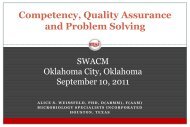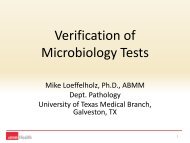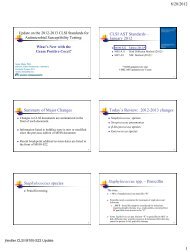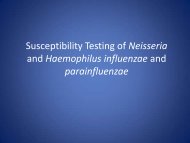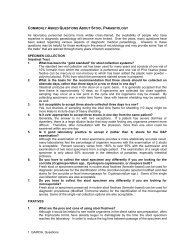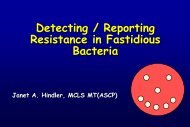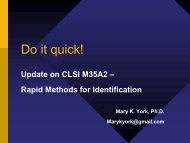Detection and Reporting of Antimicrobial Resistance - SWACM
Detection and Reporting of Antimicrobial Resistance - SWACM
Detection and Reporting of Antimicrobial Resistance - SWACM
You also want an ePaper? Increase the reach of your titles
YUMPU automatically turns print PDFs into web optimized ePapers that Google loves.
<strong>Detection</strong> <strong>and</strong> <strong>Reporting</strong> <strong>of</strong><br />
<strong>Antimicrobial</strong> <strong>Resistance</strong>: gram<br />
positives (MRSA, VISA,<br />
VRSA, VRE, Spneu) Spneu<br />
Janet Hindler, MCLS MT(ASCP)<br />
UCLA Medical Center<br />
Los Angeles, California<br />
jhindler@ucla.edu
At the conclusion <strong>of</strong> this talk, you<br />
will be able to…… to……<br />
♦Describe Describe the methods available for<br />
detection <strong>of</strong> MRSA. MRSA<br />
♦Discuss Discuss concerns related to vancomycin<br />
<strong>and</strong> S. aureus including VISA, VRSA <strong>and</strong><br />
hVISA.<br />
♦List List points to consider for AST <strong>of</strong><br />
coagulase-negative coagulase negative staphylococci (CoNS).<br />
♦Describe Describe the recent changes in penicillin<br />
breakpoints for Streptococcus pneumoniae
Beta-<br />
lactams<br />
<strong>Antimicrobial</strong> Agent Options for<br />
MSSA Infections<br />
Predictable activity<br />
dicloxacillin / nafcillin<br />
cephalexin / cefazolin<br />
amoxicillin-clavulanic amoxicillin clavulanic acid<br />
ampicillin-sulbactam<br />
ampicillin sulbactam<br />
carbapenem (e.g., imipenem)<br />
vancomycin<br />
daptomycin<br />
linezolid<br />
quinupristin-dalfopristin<br />
quinupristin dalfopristin<br />
tigecycline<br />
Need AST<br />
clindamycin<br />
trimethoprim-sulfa<br />
trimethoprim sulfa<br />
macrolide (e.g.<br />
clarithromycin)<br />
tetracycline<br />
fluoroquinolone (e.g.<br />
cipr<strong>of</strong>loxacin)<br />
(gentamicin)<br />
(rifampin)
Beta-<br />
lactams<br />
<strong>Antimicrobial</strong> Agent Options for<br />
MRSA Infections<br />
Predictable activity<br />
dicloxacillin / nafcillin<br />
cephalexin / cefazolin<br />
amoxicillin-clavulanic amoxicillin clavulanic acid<br />
ampicillin-sulbactam<br />
ampicillin sulbactam<br />
carbapenem (e.g., imipenem)<br />
vancomycin<br />
daptomycin<br />
linezolid<br />
quinupristin-dalfopristin<br />
quinupristin dalfopristin<br />
tigecycline<br />
Need AST<br />
clindamycin<br />
trimethoprim-sulfa<br />
trimethoprim sulfa<br />
macrolide (e.g.<br />
clarithromycin)<br />
tetracycline<br />
fluoroquinolone (e.g.<br />
cipr<strong>of</strong>loxacin)<br />
(gentamicin)<br />
(rifampin)
MRSA MRSA<br />
MRSA<br />
MRSA – methicillin methicillin-resistant<br />
methicillin methicillin<br />
methicillin<br />
methicillin resistant resistant<br />
resistant<br />
S. S. S. S. aureus aureus<br />
aureus<br />
aureus<br />
aureus<br />
- Oxacillin Oxacillin Oxacillin Oxacillin vs. vs. vs. vs. cefoxitin cefoxitin cefoxitin cefoxitin tests tests tests tests to to to to detect<br />
detect<br />
detect<br />
detect<br />
mec mecA-mediated mec<br />
mec<br />
mec mediated mediated mediated oxacillin oxacillin oxacillin oxacillin resistance<br />
resistance<br />
resistance<br />
resistance
Tests for mecA-mediated mec mediated Oxacillin<br />
<strong>Resistance</strong> in S. aureus<br />
♦Phenotypic Phenotypic tests<br />
– Disk diffusion or MIC<br />
• Cefoxitin as a surrogate<br />
– Report results for OXACILLIN, OXACILLIN,<br />
not cefoxitin<br />
• Oxacillin<br />
– Oxacillin-salt Oxacillin salt agar screen for S. aureus<br />
♦<strong>Detection</strong> <strong>Detection</strong> <strong>of</strong> gene or gene product<br />
– Gene = mecA mec<br />
– Gene product = penicillin binding protein (PBP) 2a
Specimen: Joint fluid<br />
Diagnosis: Septic arthritis<br />
Staphylococcus aureus<br />
(cefoxitin MIC (µg/ml ( g/ml)<br />
≤4 4 S)<br />
clindamycin >8 R<br />
erythromycin >8 R<br />
oxacillin 4 R<br />
penicillin R<br />
vancomycin ≤0.5 0.5 S<br />
What should we do?<br />
(commercial panels <strong>of</strong>ten contain both cefoxitin <strong>and</strong> oxacillin)
Results for 135 “Difficult Difficult” Isolates<br />
<strong>of</strong> S. aureus<br />
Method<br />
CX-DD CX DD 18h<br />
OX DD 24h<br />
*CX-MIC *CX MIC 18h<br />
OX MIC 24h<br />
OX salt agar 24h<br />
* * * * borderline borderline borderline borderline MRSA<br />
MRSA<br />
MRSA<br />
MRSA<br />
mecA mecA<br />
pos (n=79)<br />
No. w/ result<br />
S<br />
2<br />
7<br />
1<br />
12<br />
12<br />
I or R<br />
77<br />
72<br />
78<br />
67<br />
67<br />
SENS<br />
98%<br />
91<br />
99<br />
85%<br />
85%<br />
mecA mecA<br />
neg (n=56)<br />
No. w/ result<br />
S<br />
56<br />
33<br />
53<br />
49<br />
28<br />
I or R<br />
0<br />
23<br />
3<br />
7*<br />
28<br />
SPEC<br />
100%<br />
59<br />
95<br />
88%<br />
50%<br />
Swenson et al. 2007. Diagn Microbiol Infect Dis. 58:33.
<strong>Detection</strong> <strong>of</strong> Oxacillin <strong>Resistance</strong><br />
in S. aureus<br />
mecA mecA<br />
or PBP2a<br />
Pos<br />
Neg<br />
Neg<br />
Oxacillin MIC (µg/ml) ( g/ml)<br />
any<br />
≤ 2<br />
≥ 4<br />
Report oxacillin<br />
resistant<br />
susceptible<br />
resistant a<br />
a<br />
Rare occurrence <strong>of</strong> oxacillin resistance mechanisms other<br />
than mecA mecA<br />
(e.g. “borderline borderline” oxacillin resistance)…<br />
resistance)<br />
“These These isolates may test susceptible to cefoxitin” cefoxitin<br />
CLSI M100-S19. M100 S19. Table 2C.
Cefoxitin Tests for<br />
mecA-mediated<br />
mec mediated Oxacillin <strong>Resistance</strong><br />
in S. aureus<br />
♦Highly Highly sensitive <strong>and</strong> specific in<br />
detecting mecA-mediated mec mediated resistance;<br />
better than oxacillin for “difficult difficult to<br />
detect MRSA” MRSA<br />
♦Fails Fails to detect oxacillin-R<br />
oxacillin R mecA mecA<br />
negative isolates (e.g., “borderline borderline”<br />
isolates)
What about “borderline borderline MRSA”? MRSA<br />
♦mecA mecA<br />
negative <strong>and</strong> oxacillin MICs slightly<br />
above “R” breakpoint<br />
♦Mechanisms: Mechanisms:<br />
lactamase - ⇑ β-lactamase lactamase causes ⇑ oxacillin MIC<br />
1)β-lactamase<br />
1)<br />
2) MOD-SA MOD SA - modified PBPs 1,2,4<br />
♦Infrequently Infrequently encountered<br />
♦Limited Limited clinical information in literature re:<br />
therapy<br />
• May be treatable with β-lactam lactam agents<br />
• Some reports that they do respond to β-lactam lactam<br />
Chambers. 1997. Clin Microbiol Rev. 10:781.
Cloxacillin Clinical Failure for<br />
Endocarditis due to Borderline<br />
Oxacillin Resistant S. aureus<br />
♦ 43 yo IV drug user<br />
♦ Past 16 months, 4 admissions for MSSA endocarditis,<br />
osteomyelitis<br />
– Incomplete Rx – pt. left against medical advice<br />
– Rx. cloxacillin + rifampin<br />
♦ 5th admission blood cultures – S. aureus (mec mecA A neg)<br />
– Oxacillin: MIC = 12 µg/ml g/ml (Etest); ≥4 4 µg/ml g/ml (Vitek2); no zone (KB)<br />
– Rifampin – R<br />
– Pt responded to vancomycin<br />
– Some S. aureus isolates atypical phenotype<br />
Skinner et al. 2009. J Clin Microbiol. 47:859.
Commercial AST S<strong>of</strong>tware<br />
S. aureus – OX / CX Testing<br />
OX<br />
S<br />
R<br />
R<br />
S<br />
CX<br />
S<br />
R<br />
S<br />
R<br />
*may be borderline MRSA<br />
Report:<br />
S<br />
R<br />
Expertize R*<br />
Expertize R
Phoenix vs. Cefoxitin Disk Diffusion<br />
Phoenix<br />
S. aureus (N=1,066: 347 MRSA, 719 MSSA)<br />
Discrepancies<br />
Between OX/CX<br />
N<br />
1<br />
6<br />
1<br />
Phoenix<br />
OX<br />
CX<br />
R R<br />
S R<br />
R S<br />
• Isolates collected from 2006-2007 2006 2007 (Italy)<br />
• Variety <strong>of</strong> sources<br />
• Phoenix: 100% sensitivity; sensitivity;<br />
99.86% specificity<br />
*Broth dilution MIC (µg/ml): ( g/ml): oxacillin = 1; cefoxitin = 4<br />
CX-DD CX DD<br />
S*<br />
R<br />
R<br />
PBP2a<br />
Neg<br />
Pos<br />
Pos<br />
Mencacci, Mencacci,<br />
et al. 2009. JCM. 47:2288.
Phoenix <strong>and</strong> Vitek 2 vs. mecA mecA<br />
Phoenix<br />
S. aureus (N=620: 448 MRSA; 172 MSSA)<br />
System<br />
Phoenix<br />
Vitek 2<br />
OX<br />
97.8<br />
98.2<br />
Sensitivity<br />
CX<br />
99.8<br />
99.1<br />
Combined<br />
99.8<br />
99.8<br />
OX<br />
100<br />
99.4<br />
Specificity<br />
CX<br />
100<br />
100<br />
Combined<br />
100<br />
99.4<br />
Phoenix:<br />
1 mecA mecA<br />
positive isolate S to both OX <strong>and</strong> CX<br />
9 OX-S/CX OX S/CX-R R (mec ( mecA A +) changed to OX R<br />
Vitek 2:<br />
Junkins et al. 2009.<br />
1 mecA mecA<br />
positive isolate S to both OX <strong>and</strong> CX<br />
JCM. Epub 22 July 2009.<br />
1 mecA mecA<br />
negative isolate R to OX <strong>and</strong> S to CS<br />
7 OX-S/CX OX S/CX-R R (mec ( mecA A +) changed to OX R<br />
3 OX-R/CX OX R/CX-S S (3 mecA mecA<br />
+, 1 mecA mecA<br />
-) ) changed to OX R
Specimen: Joint fluid<br />
Diagnosis: Septic arthritis<br />
Staphylococcus aureus<br />
MIC (µg/ml) ( g/ml)<br />
clindamycin >8 R<br />
erythromycin >8 R<br />
oxacillin 4 R<br />
penicillin R<br />
vancomycin ≤0.5 0.5 S<br />
Final Report<br />
If oxacillin or cefoxitin = R<br />
then report oxacillin R<br />
May be a rare “borderline borderline oxacillin-R” oxacillin isolate.<br />
Currently, no rule to distinguish these from mecA mecA<br />
strains.
How should we define MRSA? MRSA<br />
♦mec mecA? A?<br />
♦Oxacillin Oxacillin MIC >2 µg/ml? g/ml?<br />
Definition may be a hospital-<br />
acquired infection (HAI) issue as<br />
well as a clinical issue
Scenario: MRSA Surveillance vs.<br />
Diagnostic Testing for MRSA<br />
♦Patient Patient’s s results:<br />
– MRSA surveillance: negative<br />
– Wound culture: MRSA (oxacillin MIC 4 µg/ml) g/ml)<br />
Is this an HAI?<br />
Surveillance tests: target mecA mec<br />
Diagnostic tests: target mecA mecA<br />
<strong>and</strong>/or oxacillin MIC >2 µg/ml g/ml
Penicillin Penicillin Penicillin Penicillin <strong>and</strong> <strong>and</strong><br />
<strong>and</strong><br />
<strong>and</strong> Staphylococcus Staphylococcus<br />
Staphylococcus<br />
Staphylococcus spp.<br />
spp.<br />
spp.<br />
spp.<br />
- Induced Induced<br />
Induced<br />
Induced β-lactamase lactamase lactamase lactamase testing<br />
testing<br />
testing<br />
testing
Specimen: Bone<br />
Diagnosis: Osteomyelitis<br />
Staphylococcus aureus<br />
clindamycin MIC (µg/ml) ( g/ml)<br />
≤0.5 0.5 S<br />
erythromycin ≤0.5 0.5 S<br />
oxacillin ≤0.25 0.25 S<br />
penicillin ≤0.06 0.06 S<br />
vancomycin ≤0.5 0.5 S<br />
What should we do?
Penicillin only 10.1% “S”<br />
http://www.gpcsusceptibilitydata.com/content/home.asp?page<br />
http:// www.gpcsusceptibilitydata.com/content/home.asp?page=home =home
Staphylococcus spp. - Penicillin<br />
♦ An induced β-lactamase lactamase test should be performed on<br />
staphylococcal isolates if penicillin…<br />
penicillin<br />
– MIC ≤0.12 0.12 µg/ml g/ml<br />
– Zone diameter ≥29 29 mm<br />
…..before ..before reporting the isolate as penicillin susceptible<br />
S R<br />
S R<br />
CLSI M100-S19. M100 S19. Table 2C.
Example <strong>of</strong> Induced ß-lactamase lactamase Test<br />
Oxacillin<br />
(inducer)<br />
-Sub Sub isolate to agar (e.g., BAP, MHA)<br />
-Drop Drop ß-lactam lactam disk (e.g., oxacillin,<br />
cefoxitin)<br />
-Incubate Incubate overnight<br />
-Test Test cells from periphery <strong>of</strong> zone<br />
-If If β-lactamase lactamase positive (with or<br />
without induction), report penicillin R<br />
Pos Neg
Staphylococcus aureus<br />
Phenotypic Methods for Penicillinase (1)<br />
197 S. aureus with “S” penicillin MICs<br />
Penicillin<br />
MIC (µg/ml)* ( g/ml)*<br />
Total<br />
0.03<br />
0.06<br />
0.12<br />
*Vitek 2<br />
N<br />
17<br />
81<br />
99<br />
197<br />
blaZ bla +<br />
blaZ bla = gene coding for penicillinase production in S. aureus<br />
0<br />
5<br />
23<br />
28<br />
Kaase et al. 2008. Clin Microbiol Infect. 14:614.
Staphylococcus aureus<br />
Phenotypic Methods for Penicillinase (2)<br />
Disk Diffusion<br />
(≤28 28 mm zone)<br />
16/28 (57.1)<br />
*Oxoid Oxoid nitrocefin stick<br />
28 blaZ bla Positive S. aureus<br />
N (%) positive for penicillinase with 3 phenotypic methods<br />
Disk Diffusion<br />
(sharp zone edge)<br />
20/28 (71.4)<br />
Induced Nitrocefin<br />
β-lactamase lactamase test (60 min)<br />
11/28 (39.3)<br />
Conclusion: phenotypic methods may not detect staphylococci<br />
that have blaZ bla <strong>and</strong> that might not respond to penicillin therapy<br />
Kaase et al. 2008. Clin Microbiol Infect. 14:614.
MSSA (N=24 1 ) isolated over 12 days… days<br />
Patient JD w/ endocarditis<br />
1, 6<br />
10<br />
10<br />
Day<br />
3, 4, 5, 6<br />
7, 8, 10,<br />
11, 12<br />
No.<br />
isolates<br />
3<br />
6<br />
10<br />
4<br />
1<br />
Source<br />
Blood<br />
Blood<br />
Blood<br />
Mitral valve<br />
Mitral valve<br />
Penicillin<br />
MIC (µg/ml) ( g/ml)<br />
0.25 R<br />
0.12 S<br />
>2<br />
>2<br />
0.12 S<br />
Nitrocefin<br />
β-lactamase lactamase2 Neg<br />
Neg<br />
Pos<br />
Pos<br />
Neg<br />
blaZ<br />
PCR<br />
Pos<br />
Pos<br />
Pos<br />
Pos<br />
Pos<br />
1 All isolates erythromycin-R, erythromycin R, clindamycin-R clindamycin R (inducible), same PFGE type<br />
2 Tests performed following induction with cefoxitin, oxacillin, <strong>and</strong><br />
penicillin; examined following incubation @ RT for 10 <strong>and</strong> 60 min<br />
CLSI Agenda Book, June 2009
Staphylococcus spp. - Penicillin<br />
♦UCLA UCLA protocol<br />
– Report penicillin if “R”<br />
– Suppress penicillin if “S” <strong>and</strong> add note<br />
“Contact Contact laboratory if penicillin results<br />
needed” needed<br />
If penicillin needed, perform:<br />
• induced β-lactamase lactamase test<br />
• broth dilution MIC (penicillin 0.015-4 0.015 4 µg/ml) g/ml)<br />
• retest subsequent isolates from the patient<br />
• communicate with physician
Specimen: Bone<br />
Diagnosis: Osteomyelitis<br />
Staphylococcus aureus<br />
clindamycin MIC (µg/ml) ( g/ml)<br />
≤0.5 0.5 S<br />
erythromycin ≤0.5 0.5 S<br />
oxacillin ≤0.25 0.25 S<br />
vancomycin ≤0.5 0.5 S<br />
Final Report<br />
“Contact Contact laboratory if penicillin results needed” needed
Vancomycin <strong>and</strong> S. aureus<br />
–VSSA VSSA – vancomycin-susceptible<br />
vancomycin susceptible S. aureus<br />
–VISA VISA– vancomycin-intermediate<br />
vancomycin intermediate S. aureus<br />
–VRSA VRSA – vancomycin-resistant<br />
vancomycin resistant S. aureus<br />
–hVISA hVISA – heteroresistant VISA
S. aureus - Vancomycin<br />
MIC Interpretive Criteria (µg/ml) ( g/ml)<br />
Susceptible<br />
≤2<br />
VSSA<br />
≤1 1 vs 2 µg/ml g/ml<br />
hVISA<br />
Intermediate<br />
4-8<br />
Resistant<br />
≥16 16<br />
VISA VRSA<br />
CLSI M100-S19; M100 S19; Table 2C.<br />
hVISA (h=heteroresistant) no CLSI recommendations for detecting hVISA
Ability <strong>of</strong> Various Methods to Detect Levels<br />
<strong>of</strong> Vancomycin Susceptibility in S. aureus<br />
VSSA<br />
VISA**<br />
VRSA**<br />
Vancomycin<br />
MIC (µg/ml) ( g/ml)<br />
MIC<br />
Method<br />
Disk Diffusion<br />
Method<br />
Vancomycin<br />
Agar Screen*<br />
≤2 2 S yes no yes<br />
4 I yes no variable<br />
8 I yes no yes<br />
16 R yes no yes<br />
≥32 32 R yes yes yes<br />
* BHI + 6 µg/ml g/ml vancomycin – does not detect all VISA<br />
** Report following reference lab confirmation<br />
CLSI M02-A10. M02 A10.<br />
CLSI M07-A8. M07 A8.
Disk Diffusion (DD) Breakpoints (mm ( mm)<br />
Staphylococcus spp. - Vancomycin<br />
CLSI Document Susceptible Intermediate Resistant<br />
M100-S18 M100 S18 2008 ≥15 15 - -<br />
New!<br />
M100-S19 M100 S19 2009*<br />
- - -<br />
For. S. aureus: aureus<br />
*If zone ≥7 7 mm, perform MIC test if vancomycin needed<br />
• Vancomycin DD is only reliable for detecting S. aureus<br />
containing van-A van A (VRSA); must confirm no zone (≤6 ( 6 mm) results<br />
• DD does not separate VSSA from VISA<br />
• DD does not work for CoNS<br />
CLSI M100-S19. M100 S19. Table 2C.
VISA - falsely “S” by previous (CLSI M100-S18) M100 S18)<br />
vancomycin disk diffusion breakpoints…<br />
breakpoints<br />
17 mm zone “S”<br />
S. aureus<br />
MIC – 8 µg/ml g/ml “I”
VRSA<br />
VISA<br />
VSSA<br />
Vancomycin MIC ( (µg/ml) g/ml)<br />
CLSI AST Subcommittee Agenda Book. 6/08.<br />
Vancomycin Zone Diameter<br />
vs. MIC S. aureus<br />
RES<br />
former (2008) 15 mm cut<strong>of</strong>f<br />
SUSC<br />
Vancomycin Zone (mm)
Specimen: Pleural fluid<br />
Diagnosis: Pneumonia<br />
Staphylococcus aureus<br />
MIC (µg/ml) ( g/ml)<br />
clindamycin >8 R<br />
erythromycin >8 R<br />
oxacillin >16 R<br />
penicillin R<br />
vancomycin 2 S<br />
Should we do anything about<br />
vancomycin MIC <strong>of</strong> 2 µg/ml? g/ml?
S. aureus - Vancomycin<br />
MIC Interpretive Criteria (µg/ml) ( g/ml)<br />
Susceptible<br />
≤2<br />
VSSA<br />
≤1 1 vs 2 µg/ml g/ml<br />
hVISA<br />
Intermediate<br />
4-8<br />
Resistant<br />
≥16 16<br />
VISA VRSA<br />
CLSI M100-S19; M100 S19; Table 2C.<br />
hVISA (h=heteroresistant) no CLSI recommendations for detecting hVISA
Why does it matter if vancomycin<br />
MIC is 1 vs. 2 µg/ml? g/ml?<br />
♦ Based on PK/PD, there may be different clinical<br />
outcomes if vancomycin Rx<br />
♦ Infectious Diseases Society <strong>of</strong> America (IDSA)<br />
Guidelines; if vancomycin MIC is:<br />
– ≤1 1 µg/ml /ml – maintain vancomycin trough serum<br />
concentration <strong>of</strong> 15-20 15 20 mg/L<br />
– ≥2 2 µg/ml /ml - use alternative treatment<br />
Rybak et al. Clin Infect Dis. 2009. 49:325<br />
♦ Increasing numbers <strong>of</strong> isolates with susceptible<br />
MICs <strong>of</strong> 1 <strong>and</strong> 2 µg/ml g/ml (as compared to ≤0.5 0.5<br />
µg/ml)<br />
creep”<br />
g/ml) - referred to as vancomycin “creep<br />
.
Vancomycin MICs are “Creeping Creeping up” up<br />
MRSA Blood Isolates 2001-2005 2001 2005 (N=662)<br />
MIC testing performed by Etest method<br />
Steinkraus et al. 2007. J Antimicrob Chemother. 60:788.<br />
See also…Wang also Wang et al. 2006. J Clin Microbiol. 44:3883.
Outcomes <strong>of</strong> Vancomycin Therapy in<br />
92 Patients with MRSA Bacteremia<br />
Outcome<br />
Overall failure<br />
Hospital length <strong>of</strong> stay<br />
* No. (%) <strong>of</strong> patients<br />
MIC testing performed by Etest<br />
(2005-2007)<br />
(2005 2007)<br />
VAN MIC ≥1.5 1.5<br />
(66 patients)<br />
24 (36.4)*<br />
21 (9.0-43.0) (9.0 43.0)<br />
VAN MIC
What methods should we use for routine<br />
testing <strong>of</strong> vancomycin <strong>and</strong> S. aureus?<br />
♦ Is Etest best?<br />
– More recent outcome data<br />
based on Etest<br />
♦ Method variability<br />
– Etest MICs higher than CLSI<br />
reference method MICs<br />
♦ Reproducibility <strong>of</strong> MIC tests<br />
generally +/- +/ 1 two-fold two fold dilution<br />
MIC = 1.5 µg/ml g/ml
Vancomycin MIC (N=101 MRSA)<br />
Etest MICs > Reference Broth Microdilution <strong>and</strong> Agar Dilution MICs MIC<br />
Prakash et al. 2008. Antimicrob Agents Chemother. 52:4528.<br />
See also…Hsu also Hsu et al. 2008. Intl J Antimicrob Agents. 32:378.
S. aureus - Vancomycin MIC Distribution<br />
%<br />
UCLA 2008 (889 MSSA, 662 MRSA)<br />
90<br />
80<br />
70<br />
60<br />
50<br />
40<br />
30<br />
20<br />
10<br />
0<br />
57.4 48.7<br />
42.5<br />
50.5<br />
0.1 0.8<br />
=4<br />
Vancomycin MIC (ug/ml)<br />
CLSI reference broth microdilution method<br />
MSSA<br />
MRSA
Specimen: Pleural fluid<br />
Diagnosis: Pneumonia<br />
Staphylococcus aureus<br />
clindamycin MIC (µg/ml) ( g/ml)<br />
>8 R<br />
daptomycin 0.5 S<br />
erythromycin >8 R<br />
linezolid 1 S<br />
oxacillin >16 R<br />
penicillin R<br />
vancomycin 2 S*<br />
Final report<br />
“*Vancomycin *Vancomycin MIC determined by Etest method” method
Specimen: Blood<br />
Diagnosis: Endocarditis<br />
Staphylococcus aureus<br />
MIC (µg/ml) ( g/ml)<br />
clindamycin >8 R<br />
erythromycin >8 R<br />
oxacillin >16 R<br />
penicillin R<br />
vancomycin ≤0.5 0.5 S<br />
Could this be hVISA?
What is hVISA*?<br />
♦S. S. aureus that show…. show<br />
– vancomycin MIC ≤2 2 µg/ml g/ml (S) by conventional<br />
MIC tests<br />
– subpopulation <strong>of</strong> cells with MICs 4-8 µg/ml g/ml<br />
– Increase production <strong>of</strong> bi<strong>of</strong>ilm; bi<strong>of</strong>ilm;<br />
more tolerant to<br />
“killing killing”; ; poor patient outcomes<br />
*heteroresistant VISA
What might an hVISA<br />
inoculum look like?<br />
≤0.5 0.5<br />
= 1 bacterium<br />
1<br />
2<br />
4<br />
Vancomycin MIC (µg/ml) ( g/ml)<br />
Too few “NS NS” cells to detect with<br />
st<strong>and</strong>ard inoculum size in routine<br />
AST (MIC & DD results will be “S”); );<br />
<strong>of</strong>ten slower growing<br />
S I R<br />
8<br />
16<br />
≥32 32<br />
NS, not susceptible
What methods have been used to<br />
detect hVISA?<br />
♦ Population analysis/AUC (PAP/AUC)<br />
– Place high inoculum on agar with varying vancomycin<br />
concentrations <strong>and</strong> divide by area under the population<br />
curve (gold st<strong>and</strong>ard)<br />
♦ Etest (test vancomycin <strong>and</strong> teicoplanin)<br />
– Macro method - high inoculum (McF ( McF #2) on BHI<br />
– GRD (glycopeptide resistance detection)<br />
See Yus<strong>of</strong> et al. 2008. JCM. 46:3042<br />
♦ Screen plates<br />
– MHA + 5 µg/ml g/ml teicoplanin<br />
– Other screen plates<br />
GRD Etest
Outcomes in 250 patients with<br />
Bacteremia due to hVISA or VS-MRSA VS MRSA<br />
Infection-attributable Infection attributable death<br />
Hospitalization duration, days<br />
Bacteremia, days<br />
Endocarditis<br />
Osteomyelitis<br />
hVISA<br />
(N=27)<br />
12 (44)*<br />
12 (0-207) (0 207)<br />
12 (1-123) (1 123)<br />
5 (19)<br />
7 (26)<br />
*No. (%) <strong>of</strong> patients or median value (range)<br />
hVISA identified with Etest macromethod<br />
VS-MRSA VS MRSA<br />
(N=223)<br />
81 (36)<br />
12.5 (0-184) (0 184)<br />
2 (1-92) (1 92)<br />
8 (4)<br />
16 (7)<br />
p<br />
.4<br />
.8<br />
.005<br />
.007<br />
.006<br />
Maor et al. 2009. J Infect Dis. 199:619.
Pt. X – 4 MRSA Blood Isolates (same PFGE)<br />
Endocarditis - failed vancomycin <strong>and</strong> daptomycin Rx<br />
Isolate<br />
Date<br />
9/16<br />
11/5<br />
12/4<br />
12/6<br />
Dapto<br />
BMD<br />
fresh<br />
≤0.5 0.5 S<br />
≤0.5 0.5 S<br />
4 NS<br />
4 NS<br />
MIC (µg/ml) ( g/ml)<br />
Vanc<br />
BMD<br />
fresh<br />
1 S<br />
2 S<br />
2 S<br />
4 I<br />
Vanc Etest<br />
Std.<br />
Std.<br />
fresh<br />
frozen<br />
2 S<br />
2 S<br />
4 I<br />
8 I<br />
2<br />
2<br />
2<br />
3 (I)<br />
BMD, broth microdilution<br />
Std, st<strong>and</strong>ard Etest McFarl<strong>and</strong> 0.5 / MHA<br />
Fresh, isolate tested when recovered<br />
Frozen, isolate tested after freezing<br />
PAP, population analysis<br />
hVISA Etest<br />
Macro<br />
-<br />
hVISA<br />
hVISA<br />
hVISA<br />
GRD<br />
-<br />
-<br />
hVISA<br />
hVISA<br />
PAP<br />
-<br />
hVISA<br />
hVISA<br />
hVISA<br />
Tenover et al. 2009.<br />
Intl. J. Antimicrob Agents. 33:564.
CLSI Retesting Rule<br />
♦For For S. aureus, aureus,<br />
vancomycin ”S”<br />
isolates may become vancomycin ”I”<br />
during prolonged therapy.<br />
Suggestion:<br />
Test subsequent isolates <strong>of</strong> S. aureus from<br />
similar body site after 3-4 3 4 days to see if<br />
isolate is still vancomycin-S.<br />
vancomycin S.<br />
CLSI M100-S19. M100 S19. Introduction.
Specimen: Blood<br />
Diagnosis: Endocarditis<br />
Staphylococcus aureus<br />
MIC (µg/ml) ( g/ml)<br />
clindamycin >8 R<br />
erythromycin >8 R<br />
oxacillin >16 R<br />
penicillin R<br />
vancomycin ≤0.5 0.5 S<br />
Final report<br />
“hVISA hVISA identified by Macro Etest method; Macro<br />
Etest performed at Dr. Smith’s Smith s request” request
Specimen: Blood<br />
Diagnosis: Sepsis<br />
Staphylococcus aureus<br />
clindamycin MIC (µg/ml) ( g/ml)<br />
>8 R<br />
erythromycin >8 R<br />
oxacillin >16 R<br />
penicillin R<br />
vancomycin 4 I<br />
What about VISA?
<strong>Resistance</strong> due to:<br />
# reported in USA:<br />
<strong>Detection</strong>:<br />
Colony appearance:<br />
Vancomycin<br />
susceptible<br />
VISA<br />
Thickened cell wall<br />
Less than 100<br />
Often difficult; phenotype<br />
unstable<br />
Atypical for S. aureus<br />
Cell wall<br />
Vancomycin<br />
intermediate
48 hour growth on<br />
blood agar plate<br />
VISA<br />
Marlowe, et al. 2001. J Clin Microbiol. 39:2637.<br />
MRSA (not VISA)
UCLA Patient #SS - MRSA (non-VISA) (non VISA) <strong>and</strong> VISA,<br />
Time to <strong>Detection</strong> <strong>of</strong> Growth in Blood Cultures<br />
Figure 1b<br />
Isolate<br />
B-19<br />
B-18<br />
B-17*<br />
B-16*<br />
B-15*<br />
B-14<br />
B-13*<br />
B-12<br />
B-11*<br />
B-10<br />
B-9<br />
B-8*<br />
B-7<br />
B-6<br />
B-5<br />
B-4<br />
B-3<br />
B-2<br />
B-1<br />
Patient B Blood Culture Time to Positivity<br />
* Paired bottle remained negative<br />
Aerobic Anaerobic<br />
0 0.5 1 1.5 2 2.5 3 3.5 4 4.5 5<br />
Days<br />
One VISA; all others<br />
MRSA (non-VISA)<br />
(non VISA)
Characteristics sometimes<br />
observed for VISA… VISA<br />
♦Colony Colony morphology may be atypical for S.<br />
aureus (some pinpoint)<br />
♦Delayed Delayed growth in broth (e.g., blood culture)<br />
♦Weak Weak / delayed coagulase reaction<br />
♦After After several subcultures:<br />
subcultures<br />
– Colony morphology becomes typical for S. aureus<br />
– Vancomycin MIC decreases <strong>and</strong> isolate becomes<br />
vancomycin susceptible<br />
♦MICs MICs for β-lactams lactams decrease<br />
♦MICs MICs for daptomycin increase
Specimen: Blood<br />
Diagnosis: Sepsis<br />
Staphylococcus aureus<br />
MIC (µg/ml) ( g/ml)<br />
clindamycin >8 R<br />
daptomycin 4 NS<br />
erythromycin >8 R<br />
linezolid ≤0.5 0.5 S<br />
oxacillin >16 R<br />
penicillin R<br />
vancomycin 4 I<br />
Final Report<br />
“Vancomycin<br />
Vancomycin-intermediate, intermediate, daptomycin non-susceptible*<br />
non susceptible*<br />
S. aureus; aureus;<br />
Infectious Diseases consult suggested.”<br />
suggested.
What should we do about testing<br />
vancomycin <strong>and</strong> MRSA?<br />
♦Use Use reliable MIC method for VSSA, VISA<br />
<strong>and</strong> VRSA<br />
– Avoid repeated subcultures<br />
♦Be Be consistent with testing/reporting<br />
♦Perform Perform special testing on request<br />
– There are no st<strong>and</strong>ardized recommendations for<br />
detecting hVISA in the clinical laboratory<br />
– Some questions remain re: the significance <strong>of</strong> hVISA<br />
or isolates with vancomycin MICs <strong>of</strong> 2 µg/ml g/ml<br />
Some refs… refs Falagas et. al. 2008. Clin Microbiol Infect. 14:101.<br />
Sakoulas & Moellering. 2008. Clin Infect Dis. 46(S):360.<br />
Tenover & Moellering. 2007. Clin Infect Dis. 44:1208.
…<strong>and</strong> <strong>and</strong> remember<br />
♦Clinicians Clinicians must factor in the clinical<br />
status <strong>of</strong> the patient as well as<br />
laboratory data in decision making
http://www.cdc.gov/ncidod/dhqp/pdf/ar/VRSA_testing_algo09v4.pdf
Re: vancomycin MIC… MIC when should we<br />
send staphylococci for further testing?<br />
♦S. S. aureus<br />
– MIC 4 µg/ml g/ml – maybe<br />
– MIC ≥8 8 µg/ml g/ml – yes<br />
♦CoNS CoNS<br />
– MIC ≥32 32 µg/ml g/ml – yes<br />
Check with your public health department!
Staphylococcus Staphylococcus<br />
Staphylococcus<br />
Staphylococcus spp spp. spp<br />
spp<br />
spp<br />
-Inducible Inducible Inducible Inducible clindamycin clindamycin clindamycin clindamycin resistance<br />
resistance<br />
resistance<br />
resistance
Specimen: Pus (L buttock lesion)<br />
Diagnosis: Localized Abscess<br />
Many Staphylococcus aureus<br />
clindamycin S ???<br />
erythromycin R<br />
oxacillin R<br />
penicillin R<br />
vancomycin S<br />
What should we do about clindamycin results?
S. aureus<br />
“D Zone Test”<br />
D zone test is only for<br />
staphylococci that are:<br />
Erythromycin “R” <strong>and</strong><br />
Clindamycin “S” or “I”<br />
Photo 1: inducible clindamycin R<br />
Photos 2 <strong>and</strong> 3: erythromycin R<br />
<strong>and</strong> clindamycin R (D zone test<br />
NOT needed)<br />
1<br />
2<br />
3
Staphylococcus spp.<br />
Inducible Clindamycin <strong>Resistance</strong><br />
4.0 µg/ml g/ml erythromycin<br />
0.5 µg/ml g/ml clindamycin<br />
MIC Method<br />
No growth = no inducible<br />
clindamycin resistance<br />
Growth = inducible clindamycin<br />
resistance<br />
Be careful with inoculum preparation<br />
Anecdotal data:<br />
False “S” if young colonies or underinoculated
Specimen: Pus (L buttock lesion)<br />
Diagnosis: Localized Abscess<br />
Many Staphylococcus aureus<br />
clindamycin R<br />
erythromycin R<br />
oxacillin R<br />
penicillin R<br />
vancomycin S<br />
Final Report
Erythromycin-R, Erythromycin R, Clindamycin-S<br />
Clindamycin S<br />
Staphylococci<br />
Tests for Inducible Clindamycin <strong>Resistance</strong><br />
♦Notes Notes<br />
– Test applies to S. aureus <strong>and</strong> CoNS (OX-S (OX S <strong>and</strong> OX-R) OX R)<br />
– Test not routinely done on CoNS as clindamycin<br />
rarely used for CoNS<br />
– Most hospital-associated hospital associated MRSA are clindamycin-R<br />
clindamycin<br />
– Many community-associated community associated MRSA are<br />
clindamycin-S clindamycin S (msr ( msrA A genotype)<br />
– Clindamycin can be give orally
Drug<br />
daptomycin<br />
linezolid<br />
tigecycline<br />
Newer <strong>Antimicrobial</strong> Agents<br />
S. aureus<br />
PO<br />
x<br />
Route<br />
IM<br />
IV<br />
x<br />
x<br />
x<br />
Comments<br />
FDA indications for complicated skin infxns, infxns,<br />
bacteremia; NOT for respiratory infxns (lung<br />
surfactant inhibits drug); S only breakpoint<br />
FDA indications for nosocomial pneumonia,<br />
complicated skin infxns, uncomplicated skin<br />
infxns (MSSA); severe VRE infxns; community-<br />
acquired pneumonia (MSSA); S only breakpoint<br />
FDA indications for complicated skin infxns<br />
(MRSA <strong>and</strong> MSSA); complicated intra-abdominal<br />
intra abdominal<br />
infections (MSSA only). Usually if tetracycline-S,<br />
tetracycline S,<br />
tigecycline-S;<br />
tigecycline S; S only breakpoint.
<strong>Antimicrobial</strong> Agents for<br />
S. aureus in the Pipeline!<br />
♦Lipoglycopeptides Lipoglycopeptides (IV administration)*<br />
– Dalbavancin<br />
– Oritavancin<br />
– Televancin<br />
♦Ceftobiprole Ceftobiprole (IV administration)<br />
– Broad-spectrum Broad spectrum cephalosporin with MRSA coverage<br />
– Projected to be widely prescribed<br />
*vancomycin is glycopeptide
Coagulase Coagulase-negative<br />
Coagulase<br />
Coagulase<br />
Coagulase negative negative<br />
negative<br />
staphylococci<br />
staphylococci<br />
staphylococci<br />
staphylococci<br />
(CoNS) (CoNS)<br />
(CoNS)<br />
(CoNS)<br />
(CoNS)<br />
- AST AST AST AST rules rules rules rules for for for for for various various various various species<br />
species<br />
species<br />
species
Specimen: Shunt fluid<br />
Diagnosis: Spina Bifida<br />
Coagulase-negative Coagulase negative Staphylococcus<br />
MIC (µg/ml) ( g/ml)<br />
clindamycin >8 R<br />
erythromycin >8 R<br />
oxacillin 1 R<br />
penicillin R<br />
vancomycin ≤0.5 0.5 S<br />
Should we do more testing?<br />
(isolate is PYR negative)<br />
negative
What are CLSI rules for detecting<br />
MRCoNS?<br />
Species<br />
S. lugdunensis<br />
S. saprophyticus<br />
S. epidermidis<br />
Other CoNS<br />
Rule<br />
Use oxacillin <strong>and</strong> cefoxitin breakpoints as for<br />
S. aureus<br />
Don’t Don t test; add comment to report re:<br />
appropriate therapy for S. saprophyticus UTI<br />
Use CoNS oxacillin (MIC or DD) <strong>and</strong>/or<br />
cefoxitin (DD only) breakpoints - work well<br />
Use caution for oxacillin MICs 0.5-2.0; 0.5 2.0;<br />
cefoxitin testing is better!<br />
Eliminated oxacillin disk diffusion test for CoNS (2009)!
Staphylococcus lugdunensis<br />
Identification<br />
Most commercial ID kits acceptable<br />
Courtesy <strong>of</strong> Mary York
Tests for Oxacillin <strong>Resistance</strong> in<br />
Coagulase-negative Coagulase negative Staphylococci (CoNS)<br />
(except S. lugdunensis)<br />
lugdunensis<br />
Method Susceptible Intermediate Resistant<br />
MIC – oxacillin ≤0.25 0.25 µg/ml g/ml - ≥0.5 0.5 µg/ml g/ml<br />
Disk Dif – cefoxitin* ≥25 25 mm - ≤24 24 mm<br />
*Detects mecA-mediated mec mediated oxacillin resistance (preferred test)<br />
Cefoxitin is surrogate; report oxacillin<br />
CLSI M100-S19. M100 S19. Table 2C.
Results for 196* “Routinely Routinely<br />
Encountered” Encountered CoNS<br />
Method<br />
CX-DD CX DD 24h<br />
OX DD 24h<br />
OX MIC 24h<br />
Sensitivity<br />
99%<br />
99%<br />
98%<br />
Specificity<br />
97%<br />
89%<br />
91%<br />
*126 mecA mecA<br />
positive <strong>and</strong> 70 mecA mecA<br />
negative<br />
Cefoxitin disk diffusion test least likely to call<br />
oxacillin falsely resistant!<br />
Swenson et. al. 2005. J Clin Microbiol. 43:3818.
<strong>Reporting</strong> Strategy<br />
Oxacillin MIC Results for CoNS*<br />
*”For For testing non-S. non S.<br />
epidermidis isolates<br />
from sterile sites<br />
where CoNS is<br />
causing an infection”<br />
infection<br />
Report Oxacillin<br />
Susceptible<br />
Oxacillin<br />
MIC (µg/ml) ( g/ml)<br />
≤0.25 0.25 0.5-2.0 0.5 2.0 ≥4.0 4.0<br />
Do mecA mecA<br />
or<br />
PBP2a or<br />
CEFOXITIN disk<br />
Negative Positive<br />
Report Oxacillin<br />
Susceptible<br />
Report Oxacillin<br />
Resistant<br />
Report Oxacillin<br />
Resistant
Specimen: Shunt fluid<br />
Diagnosis: Spina Bifida<br />
Coagulase-negative Coagulase negative Staphylococcus<br />
clindamycin MIC (µg/ml) ( g/ml)<br />
>8 R<br />
erythromycin >8 R<br />
oxacillin 1 R<br />
penicillin R<br />
vancomycin ≤0.5 0.5 S<br />
Final Report<br />
Oxacillin may be false resistant. Discuss case with physician<br />
<strong>and</strong> determine if further testing (e.g., cefoxitin disk diffusion, diffusion,<br />
mecA, mecA,<br />
PBP2a) is warranted.
Why is reporting “false false resistance” resistance to<br />
oxacillin in staphylococcus a concern?<br />
♦For For oxacillin-R<br />
oxacillin R staphylococci, staphylococci,<br />
drug most<br />
likely to be used is vancomycin or maybe<br />
a newer agent (e.g., linezolid, daptomycin)<br />
♦Vancomycin Vancomycin kills staphylococci slower<br />
than β-lactams lactams <strong>and</strong> has poorer tissue<br />
penetration
Specimen: Blood<br />
Diagnosis: Endocarditis<br />
Coagulase-negative Coagulase negative staphylococcus<br />
MIC (µg/ml) ( g/ml)<br />
clindamycin ≤0.5 0.5 S<br />
erythromycin ≤0.5 0.5 S<br />
oxacillin 0.5 ?<br />
penicillin ≤0.06 0.06 ?<br />
vancomycin ≤0.5 0.5 S<br />
Should we rule out S. lugdunensis?
What are some noteworthy features<br />
<strong>of</strong> S. lugdunensis?<br />
♦ Common skin commensal,<br />
commensal,<br />
<strong>of</strong>ten in inguinal area<br />
♦ Has been associated with septicemia, breast<br />
abscesses, peritonitis, infections w/ prosthetic<br />
devices, osteomyelitis, septic arthritis<br />
♦ Can cause “native native valve” valve endocarditis; most CoNS<br />
“prosthetic prosthetic valve” valve endocarditis due to S.<br />
epidermidis<br />
♦ Usually very susceptible to antimicrobial<br />
agents…including agents including penicillin-S<br />
penicillin<br />
– Only 5 - 25% penicillin-R,<br />
penicillin R, β-lactamase lactamase positive<br />
Frank et al. 2008. Clin Microbiol Rev. 21:111.
Method<br />
MIC – oxacillin*<br />
Disk Dif – cefoxitin*<br />
CLSI Interpretive Criteria<br />
S. lugdunensis<br />
Susceptible<br />
≤2 2 µg/ml g/ml<br />
≥22 22 mm<br />
Intermediate<br />
-<br />
-<br />
CLSI M100-S19. M100 S19. Table 2C.<br />
Resistant<br />
≥4 4 µg/ml g/ml<br />
≤21 21<br />
* Oxacillin MIC <strong>and</strong> cefoxitin disk diffusion breakpoints are the<br />
same as those for S. aureus
Staphylococcus lugdunensis<br />
Typical MICs<br />
MIC<br />
Interpreted w/ oxacillin<br />
breakpoints for:<br />
(µg/ml) g/ml) S. aureus CoNS<br />
cefazolin ≤0.5 0.5 S R*<br />
clindamycin erythromycin ≤0.5 0.5<br />
≤0.5 0.5<br />
S<br />
correct!<br />
S<br />
S<br />
S<br />
oxacillin 0.5 S R<br />
penicillin ≤0.06 0.06 S R*<br />
vancomycin ≤0.5 0.5 S S<br />
* Edited to “R” because <strong>of</strong> oxacillin-R oxacillin R result<br />
correct! incorrect!
Specimen: Blood<br />
Diagnosis: Endocarditis<br />
Staphylococcus lugdunensis<br />
MIC (µg/ml) ( g/ml)<br />
clindamycin ≤0.5 0.5 S<br />
erythromycin ≤0.5 0.5 S<br />
oxacillin 0.5 S<br />
penicillin ≤0.06 0.06 S<br />
vancomycin ≤0.5 0.5 S<br />
Final Report
Can S. lugdunensis be a<br />
contaminant in blood cultures?<br />
♦11/01 11/01-1/08 1/08 - 29 / 5784 single pos blood<br />
culture w/ CoNS = S. lugdunensis<br />
♦14/29 14/29 (48%) not acknowledged<br />
♦6/29 6/29 (21%) considered contaminant<br />
♦9/21 9/21 (31%) true bacteremia<br />
S. lugdunensis can be blood culture contaminant<br />
Fadel et al. 2009. Abst Ann ASM Meeting. #C-082. #C 082.
Specimen: Urine<br />
Diagnosis: Acute cystitis<br />
>10 5 CFU/ml S. saprophyticus<br />
Should we perform AST?
Specimen: Urine<br />
Diagnosis: Acute cystitis<br />
>10 5 CFU/ml S. saprophyticus<br />
Final Report<br />
“Staphylococcus Staphylococcus saprophyticus<br />
typically responds to urine<br />
concentrations <strong>of</strong> agents commonly<br />
used to treat acute, uncomplicated<br />
UTIs (e.g. nitr<strong>of</strong>urantoin, TMP-SMX, TMP SMX,<br />
or a fluoroquinolone).”<br />
fluoroquinolone).<br />
CLSI CLSI CLSI CLSI says says says says no no no no need need need need need to to to to test test…<br />
test<br />
test<br />
test<br />
CLSI M100-S19. M100 S19. Table 2C.
What about S. saprophyticus vs. other<br />
CoNS in urine?<br />
♦S. S. saprophyticus<br />
– Predominantly from young, sexually active females<br />
– Can cause upper <strong>and</strong> lower UTI<br />
– Contaminant in urine only 5% <strong>of</strong> the time<br />
♦Other Other CoNS (predominantly S. epidermidis)<br />
– Almost exclusively from inpatients with complications <strong>of</strong><br />
urinary tract (e.g., catheter, urological surgery,<br />
transplant, stones)<br />
– When present in urine, significant only 10% <strong>of</strong> the time<br />
Archer, GL et. al. 2005. Chpt. Chpt.<br />
193. In M<strong>and</strong>ell, Douglas, <strong>and</strong> Bennett’s Bennett s Principles<br />
<strong>and</strong> Practices <strong>of</strong> Infectious Diseases. 6 th ed. Elsevier Churchill Livingstone.
Streptococcus pneumoniae<br />
- Newer penicillin breakpoints<br />
- AST <strong>and</strong> reporting
Specimen: Blood<br />
Diagnosis: Pneumonia<br />
Streptococcus pneumoniae<br />
MIC (µg/ml) ( g/ml)<br />
ceftriaxone (meningitis) 0.5 S<br />
ceftriaxone (non-meningitis)<br />
(non meningitis) 0.5 S<br />
erythromycin >1 R<br />
lev<strong>of</strong>loxacin 1 S<br />
meropenem ≤0.25 0.25 S<br />
penicillin 1 ???<br />
vancomycin 0.5 S<br />
How do we interpret penicillin results?
Streptococcus pneumoniae<br />
Penicillin (µg/ml) ( g/ml)<br />
Susc Int Res<br />
Penicillin parenteral (nonmeningitis) ≤2 4 ≥8<br />
Penicillin parenteral (meningitis) ≤0.06 .06 - ≥0.1 0.12<br />
Penicillin (oral penicillin V) ≤0.06 .06 0.12-1 0.12 ≥2<br />
Table Table Table Table 2G 2G 2G 2G has has has has several several several several therapy therapy therapy therapy (Rx) (Rx) (Rx) (Rx) comments comments comments comments for for for for each each each each category<br />
category<br />
category<br />
category<br />
CLSI M100-S19. M100 S19. Table 2G.
Final Report<br />
Specimen: Blood<br />
Diagnosis: Pneumonia<br />
Streptococcus pneumoniae<br />
ceftriaxone (meningitis) MIC (µg/ml) ( g/ml)<br />
0.5 S<br />
ceftriaxone (non-meningitis)<br />
(non meningitis) 0.5 S<br />
erythromycin >1 R<br />
lev<strong>of</strong>loxacin 1 S<br />
meropenem ≤0.25 0.25 S<br />
penicillin (meningitis) 1 R<br />
penicillin (nonmeningitis) 1 S<br />
penicillin (oral penicillin V) 1 I<br />
vancomycin 0.5 S
Specimen: CSF<br />
Diagnosis: Meningitis<br />
Streptococcus pneumoniae<br />
MIC (µg/ml)<br />
ceftriaxone (meningitis) 0.5 S<br />
meropenem ≤0.25 0.25 S<br />
penicillin (meningitis) ≤0.06 0.06 S<br />
vancomycin 0.5 S<br />
Rx. Use <strong>of</strong> ceftriaxone in meningitis requires therapy with<br />
maximum doses.<br />
Rx. Use <strong>of</strong> penicillin in meningitis requires therapy with<br />
maximum doses <strong>of</strong> IV penicillin (e.g., at least 3 million units<br />
every four hours in adults with normal renal function).
Applying penicillin, cefotaxime,<br />
ceftriaxone breakpoints….<br />
breakpoints<br />
♦CSF CSF specimens<br />
– Report penicillin, cefotaxime, ceftriaxone using<br />
meningitis breakpoints ONLY<br />
♦All All other specimens<br />
– Report penicillin, cefotaxime, ceftriaxone using<br />
both meningitis <strong>and</strong> nonmeningitis breakpoints
What about all <strong>of</strong> the S. pneumoniae<br />
Rx comments?<br />
comments<br />
♦Most Most relate to recommended dosages<br />
♦Some Some relate to predicting results for other<br />
beta-lactams beta lactams based on penicillin MIC<br />
♦Add Add to your reports…. reports if your medical<br />
director deems this is appropriate<br />
– …or or perhaps there are other mechanisms for proper<br />
dosing in your facility?
Streptococcus pneumoniae<br />
Disk diffusion method - Use oxacillin disk as<br />
surrogate for penicillin susceptibility<br />
Disk<br />
content<br />
Penicillin 1 µg g<br />
oxacillin<br />
Zone (mm) MIC (µg/ml) ( g/ml)<br />
Equivalent<br />
R I S R S<br />
- - ≥20 20 - ≤0.06* 0.06*<br />
* correlates with meningitis <strong>and</strong> oral breakpoints<br />
CLSI M100-S19. M100 S19. Table 2G.
Streptococcus pneumoniae<br />
Oxacillin Disk Test for Penicillin Susceptibility<br />
♦≥20 20 mm - Report “S” for:<br />
– penicillin<br />
– cefotaxime/ ceftriaxone<br />
– other ß-lactams lactams<br />
♦≤19 9 mm - Perform MICs for:<br />
– penicillin<br />
♦Oxacillin Oxacillin disk S or ≥20 20 mm correlates with<br />
meningitis or penicillin oral S breakpoints<br />
(MIC ≤0.06 0.06 µg/ml) g/ml)<br />
CLSI M100-S19. M100 S19. Table 2G.
Oxacillin Disk as Surrogate for Penicillin<br />
Susceptibility in S. pneumoniae<br />
OX<br />
1<br />
OX<br />
1<br />
≥20 20 mm – report penicillin as S<br />
When penicillin MIC was performed on this<br />
isolate, MIC = 0.03 µg/ml g/ml<br />
≤19 19 mm – perform penicillin MIC<br />
When penicillin MIC was performed on this<br />
isolate, MIC = 1 µg/ml g/ml<br />
“S” for non-meningitis non meningitis infections (e.g.,<br />
pneumonia)<br />
CLSI M100-S19. M100 S19. Table 2G.
How are S. pneumoniae AST results<br />
used to guide therapy <strong>of</strong> meningitis?<br />
meningitis<br />
♦Empiric Empiric therapy – generally 3 rd generation<br />
cephalosporin (e.g., cefotaxime or<br />
ceftriaxone) + vancomycin<br />
♦AST AST results<br />
– May discontinue vancomycin <strong>and</strong> use β-lactam lactam alone if:<br />
• Penicillin MIC ≤0.06 0.06 µg/ml g/ml<br />
• Ceftriaxone / cefotaxime MIC ≤0.5 0.5 µg/ml g/ml<br />
Sanford Guide 2009.
How are S. pneumoniae AST results used<br />
to guide therapy <strong>of</strong> CAP (community-<br />
acquired pneumonia)?<br />
pneumonia)<br />
♦Empiric Empiric therapy - resources<br />
– IDSA (Infectious Disease Society <strong>of</strong> America) <strong>and</strong> ATC<br />
(American Thoracic Society)<br />
M<strong>and</strong>ell et al. 2007. Clin Infect Dis. 44:227.<br />
– Published surveillance data<br />
– Local cumulative antibiogram data<br />
♦AST AST results<br />
– May modify therapy if poor response to empiric therapy
Recommended Empirical Antibiotics<br />
for CAP in Outpatients<br />
Clinical Condition<br />
Previously healthy, no antimicrobials<br />
within previous 3 mos.<br />
Comorbidities (e.g. chronic heart,<br />
lung, liver, or renal disease, diabetes<br />
mellitus, alcoholism, malignancies,<br />
asplenia; immunosuppressed; use <strong>of</strong><br />
antimicrobials within previous 3 mos;<br />
other risks for DRSP<br />
In regions where high incidence <strong>of</strong><br />
macrolide-R<br />
macrolide R S. pneumoniae (including<br />
those w/o comorbidities)<br />
Recommended <strong>Antimicrobial</strong>s<br />
A macrolide<br />
Doxycycline<br />
Respiratory fluoroquinolone<br />
(lev<strong>of</strong>loxacin [750 mg],<br />
moxifloxacin, gemifloxacin)<br />
β-lactam lactam plus a macrolide<br />
“ “ “<br />
Adapted from M<strong>and</strong>ell L et al. 2007. Clin Infect Dis. 44(suppl 2):S27. 2) :S27.
Summary (1)<br />
♦ Cefoxitin disk diffusion <strong>and</strong> cefoxitin MIC tests are<br />
more sensitive in detecting mecA-mediated<br />
mec mediated<br />
resistance in S. aureus than tests using oxacillin.<br />
♦ Borderline oxacillin resistance in S. aureus may be<br />
missed with cefoxitin tests; borderline oxacillin<br />
resistance is rare in S. aureus <strong>and</strong> has not been<br />
reported in CoNS.<br />
♦ Borderline oxacillin resistant S. aureus may not be<br />
clinically significant.<br />
♦ Current phenotypic methods may not detect<br />
staphylococci that produce low levels <strong>of</strong> beta-<br />
lactamase.<br />
lactamase
Summary (2)<br />
♦ Vancomycin disk diffusion test should only be used to rule<br />
out VRSA; it cannot distinguish VISA from VSSA.<br />
♦ Serious infections caused by MRSA with vancomycin<br />
MICs <strong>of</strong> >1 µg/ml g/ml may not respond as well to vancomycin<br />
therapy as MRSA with vancomycin MICs <strong>of</strong> ≤1 1 µg/ml. g/ml.<br />
♦ Different methods may result in different vancomycin MICs<br />
for vancomycin-S<br />
vancomycin S S. aureus. aureus.<br />
Etest produces higher<br />
vancomycin MICs than CLSI broth microdilution reference<br />
method.<br />
♦ There are currently no CLSI or other st<strong>and</strong>ard<br />
recommendations for testing for hVISA.<br />
♦ VISA <strong>and</strong> hVISA are <strong>of</strong>ten slow growing <strong>and</strong> may yield a<br />
variety <strong>of</strong> colony morphologies.
Summary (3)<br />
♦ Erythromycin-R Erythromycin R <strong>and</strong> clindamycin-S clindamycin S staphylococci<br />
should NOT be reported as clindamycin-S clindamycin S without<br />
performance <strong>of</strong> a test for inducible clindamycin<br />
resistance (e.g., D zone test).<br />
♦ Oxacillin disk diffusion test was eliminated for<br />
CoNS in 2009.<br />
♦ Oxacillin MIC tests work well for S. epidermidis<br />
but can overcall oxacillin-R oxacillin R in other CoNS that<br />
lack mecA. mecA.<br />
The cefoxitin disk diffusion test is<br />
better.<br />
♦ Most S. lugdunensis are mecA mecA<br />
negative <strong>and</strong> more<br />
than 75% are β-lactamase lactamase negative.
Summary (4)<br />
♦ S. saprophyticus are predictably susceptible to<br />
drugs commonly used to treat UTIs; UTIs;<br />
susceptibility testing <strong>of</strong> S. saprophyticus from<br />
urine is not needed.<br />
♦ Species <strong>of</strong> CoNS other than S. saprophyticus<br />
rarely cause UTIs. UTIs<br />
♦ The newer CLSI penicillin breakpoints should be<br />
used for S. pneumoniae as they better predict<br />
potential utility <strong>of</strong> penicillins in treating<br />
pneumococcal pneumonia.<br />
♦ Penicillin MIC should be done on S. pneumoniae<br />
that have oxacillin zones ≤19 19 mm.





